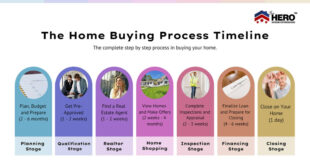Pre-Approval vs. Pre-Qualified: Key Differences for Homebuyers. When buying a home, you often hear terms like “pre-approval” and “pre-qualified.” While these terms might seem interchangeable, they represent different steps in the mortgage process. Understanding their differences can give you an edge in securing your dream home.
What is Pre-Qualification?
Pre-qualification is the initial step in the mortgage process. It provides an estimate of how much you might be able to borrow based on the information you provide to a lender. Here’s how it works:
- Process: You provide basic financial details, such as income, debts, and assets.
- Outcome: The lender gives you an estimate of your borrowing capacity.
- Documentation: Minimal or none; it’s primarily based on self-reported information.
Pre-qualification is informal and can often be done online or over the phone. It’s a great way to understand your budget before starting your home search.
Benefits of Pre-Qualification
- Quick and Easy: Typically takes a few minutes to complete.
- Free: Most lenders offer this service at no cost.
- Sets Expectations: Helps you gauge the price range for your home search.
Limitations of Pre-Qualification
- Not Verified: Since the data isn’t verified, it’s not a guarantee of loan approval.
- Less Credibility: Sellers may not take a pre-qualification as seriously as a pre-approval.
What is Pre-Approval?
Pre-approval is a more in-depth process that provides a conditional commitment from a lender. It’s based on a thorough review of your financial documents.
- Process: You submit detailed financial information, including pay stubs, tax returns, and bank statements.
- Outcome: The lender issues a pre-approval letter stating the loan amount you’re conditionally approved for.
- Documentation: Extensive; your financial data is thoroughly verified.
A pre-approval letter demonstrates to sellers that you’re a serious buyer with the financial means to purchase the property.
Benefits of Pre-Approval
- Stronger Negotiation Power: Sellers are more likely to prioritize offers from pre-approved buyers.
- Clear Understanding of Costs: Includes a breakdown of interest rates and potential monthly payments.
- Verified Information: Gives both you and the seller confidence in your purchasing ability.
Limitations of Pre-Approval
- Time-Consuming: Can take a few days to weeks to complete.
- Fees: Some lenders may charge an application fee.
- Temporary Validity: Typically valid for 60-90 days, requiring renewal if you don’t find a home quickly.
Key Differences Between Pre-Approval and Pre-Qualified
| Feature | Pre-Qualified | Pre-Approval |
|---|---|---|
| Depth of Review | Basic self-reported information | Verified financial documentation |
| Time to Complete | A few minutes | Several days to weeks |
| Cost | Free in most cases | May involve fees |
| Credibility with Sellers | Lower | Higher |
| Loan Commitment | No | Conditional approval |
Understanding these differences is critical for navigating the home-buying process effectively.
How to Choose Between Pre-Approval and Pre-Qualification
When deciding between pre-approval and pre-qualification, consider the following factors:
- Stage of Home Search:
- If you’re just starting, pre-qualification can help you set a realistic budget.
- If you’re ready to make offers, pre-approval is essential.
- Market Conditions:
- In competitive markets, a pre-approval letter gives you a significant edge.
- Time and Resources:
- If you’re short on time, start with pre-qualification, then move to pre-approval.
- Lender Requirements:
- Some lenders may require pre-approval before processing your loan application.
10 Tips for Navigating Pre-Approval and Pre-Qualification
- Be Honest About Your Finances: Providing accurate information ensures realistic estimates.
- Research Multiple Lenders: Compare rates and terms to find the best fit.
- Know Your Credit Score: Higher scores improve your chances of favorable terms.
- Reduce Debt: Lowering your debt-to-income ratio strengthens your application.
- Save for a Down Payment: Larger down payments can increase loan approval odds.
- Understand Loan Types: Different mortgages have varying requirements and benefits.
- Keep Documentation Ready: Prepare financial records to expedite the process.
- Avoid Major Purchases: Postpone large expenses that might affect your credit score.
- Ask Questions: Clarify terms and conditions with your lender.
- Monitor Expiry Dates: Renew pre-approvals if they lapse before closing.
10 FAQs About Pre-Approval and Pre-Qualification
- What’s the main difference between pre-approval and pre-qualification? Pre-qualification is an estimate based on self-reported data, while pre-approval involves verified financial documentation.
- Do I need both pre-approval and pre-qualification? No, but pre-qualification can be a preliminary step before pursuing pre-approval.
- How long does pre-approval take? Typically a few days to a few weeks, depending on the lender.
- Is pre-qualification free? Most lenders offer it at no cost.
- Does pre-approval guarantee a loan? No, it’s a conditional commitment pending final underwriting.
- Can pre-approval affect my credit score? Yes, because it involves a hard credit inquiry.
- How long is a pre-approval valid? Usually 60-90 days.
- What happens if my financial situation changes after pre-approval? Changes can affect your approval status and loan terms.
- Can I get pre-approved with bad credit? It’s possible but may involve stricter terms or higher interest rates.
- Do all sellers require pre-approval? Not all, but it significantly strengthens your offer in competitive markets.
Conclusion
Pre-approval and pre-qualification are crucial tools in the home-buying journey, each serving distinct purposes. Pre-qualification offers a quick estimate of your borrowing capacity, making it ideal for initial planning. Pre-approval, on the other hand, involves a thorough financial review and positions you as a serious buyer in the eyes of sellers.
Understanding these differences and leveraging the right tool at the right time can make your home-buying experience smoother and more successful. Whether you’re just starting or ready to make an offer, knowing your financial standing is key to securing your dream home.
 mortgage.kbk.news
mortgage.kbk.news
